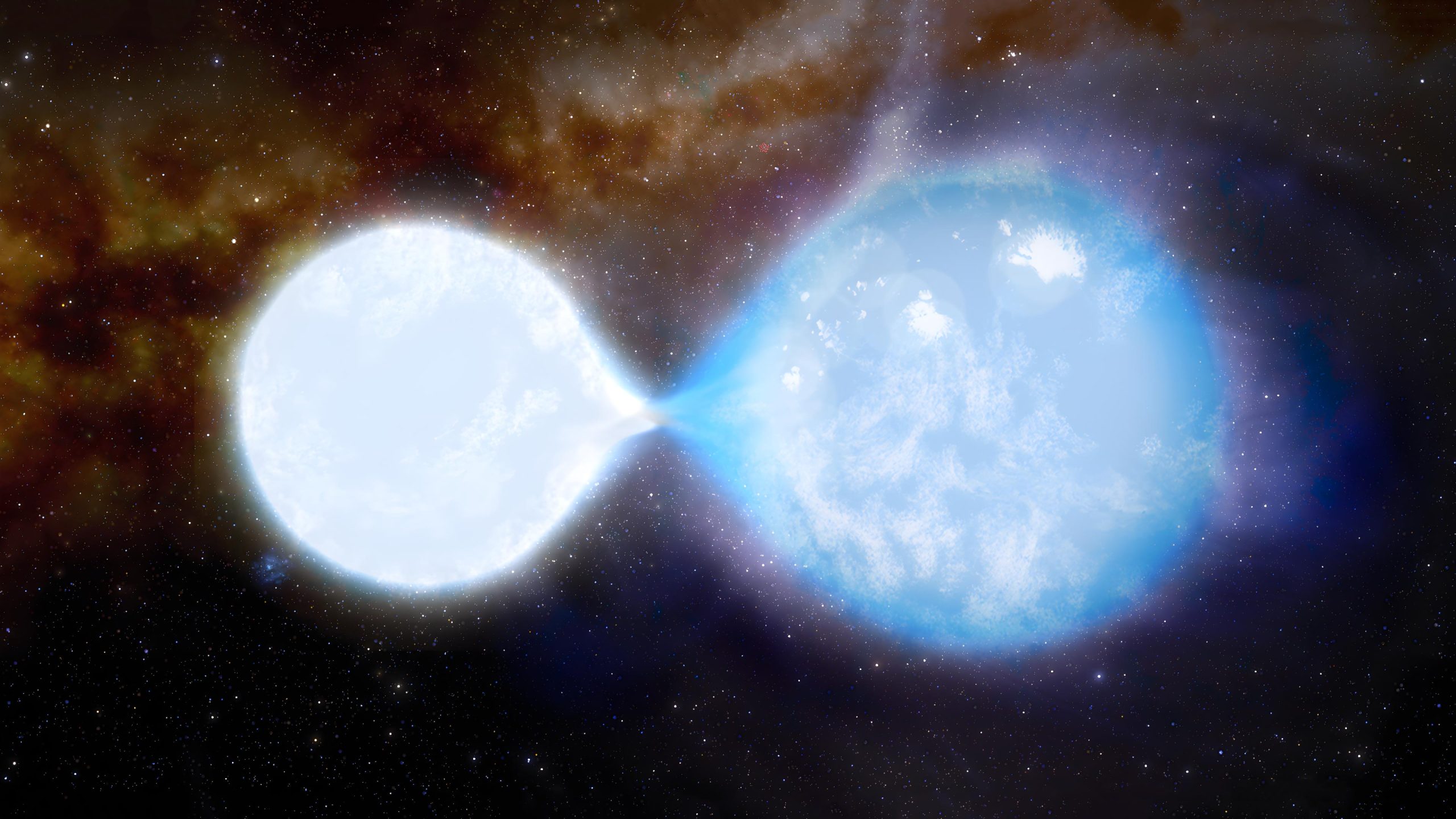النجم الأصغر والأكثر إشراقًا والأكثر سخونة (على اليسار) ، والذي تبلغ كتلته 32 مرة كتلة شمسنا ، يفقد حاليًا كتلته لصالح رفيقه الأكبر (على اليمين) ، الذي تبلغ كتلته 55 ضعف كتلة شمسنا. النجوم بيضاء وزرقاء لأنها شديدة الحرارة: 43000 و 38000 درجة كلفن على التوالي. الائتمان: UCL / J. daSilva
كشفت دراسة جديدة أجراها باحثون في جامعة كوليدج لندن وجامعة بوتسدام ، أن نجمين ملامسين هائلين في مجرة مجاورة في طريقهما إلى أن يصبحا ثقوبًا سوداء ستصطدم معًا في النهاية ، مما يولد موجات في نسيج الزمكان.
الدراسة مقبولة للنشر في المجلة علم الفلك والفيزياء الفلكية، نظر إلى نجم ثنائي معروف (نجمان يدوران حول مركز ثقل متبادل) ، وتحليل ضوء النجوم الذي تم الحصول عليه من مجموعة من التلسكوبات الأرضية والفضائية.
وجد الباحثون أن النجوم ، الواقعة في مجرة قزمة مجاورة تسمى سحابة ماجلان الصغيرة ، على اتصال جزئي وتتبادل المواد مع بعضها البعض ، حيث يتغذى أحد النجوم حاليًا على الآخر. يدور كل منهما حول الآخر كل ثلاثة أيام وهو أكبر النجوم الملامسة (المعروفة باسم ثنائيات الاتصال) التي تمت ملاحظتها حتى الآن.
بمقارنة نتائج ملاحظاتهم بالنماذج النظرية لتطور النجوم الثنائية ، وجدوا أنه في أفضل نموذج مناسب ، فإن النجم الذي يتم تغذيته حاليًا سيصبح ثقبًا أسود وسيتغذى على نجمه المصاحب. النجم الباقي سيصبح a[{” attribute=””>black hole shortly after.
These black holes will form in only a couple of million years, but will then orbit each other for billions of years before colliding with such force that they will generate gravitational waves – ripples in the fabric of space-time – that could theoretically be detected with instruments on Earth.
PhD student Matthew Rickard (UCL Physics & Astronomy), lead author of the study, said: “Thanks to gravitational wave detectors Virgo and LIGO, dozens of black hole mergers have been detected in the last few years. But so far we have yet to observe stars that are predicted to collapse into black holes of this size and merge in a time scale shorter than or even broadly comparable to the age of the universe.
“Our best-fit model suggests these stars will merge as black holes in 18 billion years. Finding stars on this evolutionary pathway so close to our Milky Way galaxy presents us with an excellent opportunity learn even more about how these black hole binaries form.”
Co-author Daniel Pauli, a PhD student at the University of Potsdam, said: “This binary star is the most massive contact binary observed so far. The smaller, brighter, hotter star, 32 times the mass of the Sun, is currently losing mass to its bigger companion, which has 55 times our Sun’s mass.”
The black holes that astronomers see merge today formed billions of years ago, when the universe had lower levels of iron and other heavier elements. The proportion of these heavy elements has increased as the universe has aged and this makes black hole mergers less likely. This is because stars with a higher proportion of heavier elements have stronger winds and they blow themselves apart sooner.
The well-studied Small Magellanic Cloud, about 210,000 light-years from Earth, has by a quirk of nature about a seventh of the iron and other heavy metal abundances of our own Milky Way galaxy. In this respect, it mimics conditions in the universe’s distant past. But unlike older, more distant galaxies, it is close enough for astronomers to measure the properties of individual and binary stars.
In their study, the researchers measured different bands of light coming from the binary star (spectroscopic analysis), using data obtained over multiple periods of time by instruments on NASA’s Hubble Space Telescope (HST) and the Multi Unit Spectroscopic Explorer (MUSE) on ESO’s Very Large Telescope in Chile, among other telescopes, in wavelengths ranging from ultraviolet to optical to near-infrared.
With this data, the team were able to calculate the radial velocity of the stars – that is, the movement they made towards or away from us – as well as their masses, brightness, temperature and orbits. They then matched these parameters with the best-fit evolutionary model.
Their spectroscopic analysis indicated that much of the outer envelope of the smaller star had been stripped away by its larger companion. They also observed the radius of both stars exceeded their Roche lobe – that is, the region around a star where material is gravitationally bound to that star – confirming that some of the smaller star’s material is overflowing and transferring to the companion star.
Talking through the future evolution of the stars, Rickard explained: “The smaller star will become a black hole first, in as little as 700,000 years, either through a spectacular explosion called a supernova or it may be so massive as to collapse into a black hole with no outward explosion.
“They will be uneasy neighbors for around three million years before the first black hole starts accreting mass from its companion, taking revenge on its companion.”
Pauli, who conducted the modeling work, added: “After only 200,000 years, an instant in astronomical terms, the companion star will collapse into a black hole as well. These two massive stars will continue to orbit each other, going round and round every few days for billions of years.
“Slowly they will lose this orbital energy through the emission of gravitational waves until they orbit each other every few seconds, finally merging together in 18 billion years with a huge release of energy through gravitational waves.”
Reference: “A low-metallicity massive contact binary undergoing slow Case A mass transfer: A detailed spectroscopic and orbital analysis of SSN 7 in NGC 346 in the SMC” by M. J. Rickard and D. Pauli, Accepted, Astronomy & Astrophysics.
DOI: 10.1051/0004-6361/202346055

“مدمن ثقافة البوب. عشاق التلفزيون. نينجا الكحول. إجمالي مهووس البيرة. خبير تويتر محترف.”







More Stories
لا تزال وكالة ناسا لا تفهم السبب الجذري لمشكلة الدرع الحراري لأوريون
اكتشاف غير مسبوق في النيزك يتحدى النماذج الفيزيائية الفلكية
تواجه اليابان وجهاً لوجه مع نفاياتها الفضائية